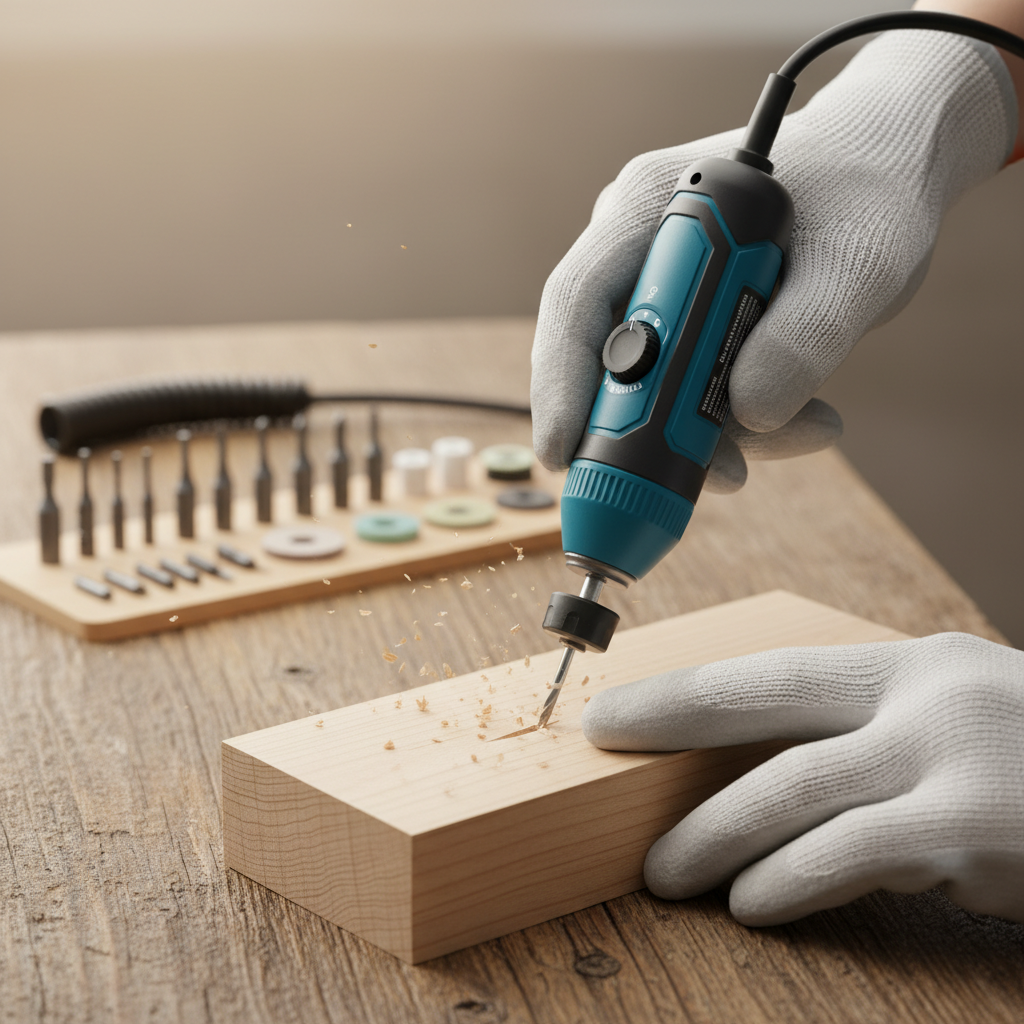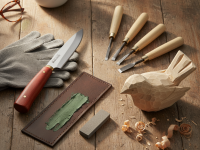Ever gazed at intricate wood carvings and thought, “I wish I could do that, but those tools look expensive and complicated!” Well, my friend, you’re not alone. Many aspiring wood carvers feel the same way. The good news? Getting into the rewarding world of power carving doesn’t have to break the bank. In fact, with the right budget-friendly rotary kit, you can start creating stuing pieces faster and with more detail than you might imagine.
I’ve been there, staring at professional setups with price tags that made my wallet weep. But through years of trial, error, and plenty of wood dust, I’ve discovered that excellent results can absolutely be achieved with affordable tools. This article is your personal guide, born from my own hands-on experience, to navigating the market and picking a budget rotary kit that will ignite your passion without emptying your pockets.
Why Power Carving? A Game-Changer for Woodworkers
If you’re used to traditional hand carving with chisels and gouges, you know it’s a meditative, often slow process that demands significant physical effort and a precise hand. While there’s undeniable beauty in that, power carving offers a different kind of magic. Here’s why I, and countless others, swear by it:
- Speed & Efficiency: Removing material rapidly is where power carving shines. Roughing out a shape that might take hours by hand can be done in minutes.
- Precision & Detail: With various tiny bits, you can achieve incredibly fine details, textures, and undercuts that are challenging, if not impossible, with larger hand tools.
- Versatility: Rotary tools aren’t just for carving. With different attachments, you can sand, polish, grind, engrave, and even cut. It’s truly a multi-purpose workhorse.
- Reduced Physical Strain: Let the tool do the heavy lifting! This means less fatigue, especially during longer carving sessions, and it can be a blessing for those with hand or wrist issues.
I remember my first time trying a rotary tool on a piece of basswood. The way it effortlessly removed wood, creating smooth curves and sharp lines, was an absolute revelation. It felt like unlocking a new superpower in my workshop!
What Exactly is a Rotary Tool (and Why You Need One)?
At its heart, a rotary tool is a handheld power tool with a high-speed rotating motor that accepts various interchangeable bits. Think of it as a super-powered, miniature drill. The magic lies in the bits – they come in a dazzling array of shapes, sizes, and materials, each designed for a specific task:
- Carving & Engraving Bits: Often made from high-speed steel or carbide, these are your primary weapons for shaping wood.
- Sanding Bands & Discs: For smoothing rough areas, shaping contours, and preparing surfaces for finishing.
- Grinding Stones: Useful for shaping harder woods or even other materials.
- Polishing Wheels: To bring out the natural sheen of the wood or apply finishes.
- Cut-Off Wheels: For small cuts or trimming.
For power carving, the rotary tool is the essential hub of your operation. It provides the high RPM (revolutions per minute) needed to efficiently remove wood, and its compact size allows for incredible maneuverability and control, which is paramount for intricate work.
Decoding the ‘Budget-Friendly’ Part: What to Look For
When we talk “budget-friendly,” we’re not talking about sacrificing quality entirely. It’s about smart shopping and knowing which features are crucial and which you can live without as a begier. Based on my experience, here’s what to prioritize:
Variable Speed Control: Your Best Friend
Seriously, this is non-negotiable. A rotary tool that only has one speed (usually very fast) is incredibly difficult to control, especially for detail work. Variable speed allows you to slow down for precision, delicate cuts, and polishing, and speed up for aggressive material removal. Trust me, your carving will thank you for this feature.
Motor Power & RPM Range
While you don’t need industrial-grade power, a decent motor will ensure your tool doesn’t bog down easily, especially when working on slightly harder woods. Look for kits that offer a good RPM range, typically from 5,000 to 35,000 RPM. More power often means more consistent performance, even under load.
Ergonomics & Comfort: It Matters!
You’ll be holding this tool for extended periods. A lightweight, comfortable, and well-balanced design will make a huge difference in reducing hand fatigue and improving control. Look for tools with rubberized grips or slim profiles. Your hands will thank you after a long carving session.
The All-Important Accessory Kit
Many budget rotary kits come with a generous assortment of bits, sanding drums, polishing wheels, and even a flexible shaft attachment. This is where you get incredible value! A good starter kit should include:
- Several carving/engraving bits (various shapes like ball, cylinder, cone)
- Sanding bands and mandrels
- A few grinding stones
- A polishing wheel
- Ideally, a flexible shaft for even more detailed, pen-like control.
Having a variety right out of the box means you can experiment and learn without immediately needing to buy extra accessories.
Brand Reputation & Warranty
Even in the budget category, some brands consistently offer better value, reliability, and customer support. Do a quick search for reviews. A decent warranty, even if it’s just 1-2 years, gives you peace of mind that the manufacturer stands behind their product.
Corded vs. Cordless
For budget kits, corded is generally the way to go. They offer consistent power without worrying about battery life or expensive replacement batteries. Cordless tools are fantastic for portability, but they typically come at a higher price point and might not sustain high power output for very long carving sessions.
My Top Picks for Budget-Friendly Rotary Kits (Based on Experience)
Now, let’s talk about what types of kits I’ve found to be excellent entry points. While specific brand names can change or vary by region, the *features* of good budget kits remain consistent. When you’re browsing, you’ll often see kits from brands like WEN, Meterk, TACKLIFE, or even entry-level Dremel models that offer incredible value.
1. The “All-Rounder” Starter Kit
This is often a corded rotary tool with variable speed, a motor in the 1.0-1.5 Amp range, and a comprehensive accessory kit (50-100 pieces). Many of these will include a flexible shaft, which is a game-changer for control. They strike a fantastic balance between power, versatility, and cost.
- Pros: Excellent value for money, includes most bits you’ll need to start, flexible shaft often included. Good for a wide range of begier projects.
- Cons: Might feel slightly less refined than premium brands, accessories might wear faster (but are easily replaceable).
I started with a kit very similar to this, and it served me well for many basic carvings and allowed me to explore different techniques without commitment to expensive specialized tools.
2. The “Compact & Mighty” Option
Sometimes you find a smaller, more ergonomic tool that sacrifices a bit on the accessory count but boasts a surprisingly robust motor for its size. These are great for people with smaller hands or who prioritize maneuverability above all else. You might need to buy a separate flexible shaft, but the core tool is solid.
- Pros: Excellent ergonomics, highly maneuverable for intricate details, often durable for its price point.
- Cons: Fewer accessories included, might have a slightly lower top RPM than larger models.
This type of tool often becomes my go-to for smaller, very detailed pieces where comfort over long periods is key.
3. The “Bare Bones But Solid” Tool
If your budget is extremely tight, sometimes just buying a basic, reputable rotary tool (even if it comes with minimal accessories) and then adding a small, curated set of carving bits separately is a smart move. Look for models from established budget brands that consistently get good reviews for reliability, even if they’re not fancy. You might forego the huge accessory count, but you get a durable core tool.
- Pros: Most durable core tool for the absolute minimum budget, allows you to pick specific bits you need.
- Cons: Requires separate purchase of bits, less “all-in-one” convenience.
I’ve done this when I needed a secondary tool for a specific task and already had a collection of bits. It’s a no-frills, practical approach.
Getting Started: Tips for Your First Power Carving Projects
Once you have your budget-friendly rotary kit, it’s time to make some wood chips! Here are a few tips I’ve gathered over the years to help you get started safely and effectively:
- Safety First, Always: This is paramount! Always wear safety glasses or a face shield to protect against flying debris. Gloves can protect your hands, and a dust mask is crucial to avoid inhaling fine wood dust. Seriously, don’t skip this.
- Start Simple: Begin with softwoods like basswood, balsa, or pine. They’re forgiving and easier to carve. Don’t jump straight into oak or maple.
- Practice on Scrap Wood: Before tackling your masterpiece, get a feel for the tool and different bits on scrap pieces. Understand how much pressure to apply and how different speeds affect the wood.
- Let the Tool Do the Work: Don’t force the bit into the wood. Let the high RPM do the cutting. Excessive pressure can lead to gouges, damage the bit, or even burn the wood.
- Secure Your Workpiece: Use clamps or a vise to hold your wood firmly. This prevents slips and allows you to use both hands to guide the tool safely and precisely.
- Experiment with Bits: Each bit has a unique purpose. Spend time understanding what each one does – from roughing out to creating textures and fine details.
- Work in Stages: Start with larger bits to remove bulk material, then move to progressively smaller bits for refining shape and adding detail.
- Take Breaks: Power carving can be intense. Step back, stretch your hands, and clear your head. This helps maintain focus and prevents fatigue-related mistakes.
Maintenance & Longevity: Making Your Budget Tool Last
Even budget tools can last a long time with proper care. Here’s what I do to keep my affordable rotary tools in top shape:
- Clean Regularly: Wood dust can build up in vents and around the chuck. Use a brush or compressed air to clear it out after each use.
- Check Carbon Brushes: Most rotary tools use carbon brushes that wear down over time. Budget tools might have more accessible brush caps. Keep an eye on them and replace them when they get low – it’s a cheap fix that extends tool life.
- Store Properly: Keep your tool and accessories in their case (if it came with one) or a clean, dry place to prevent damage and rust.
- Don’t Overload: Respect your tool’s limitations. If it’s struggling or getting excessively hot, you might be pushing it too hard. Take smaller passes.
Conclusion
The world of power carving is incredibly accessible, even if you’re working with a tight budget. You don’t need the most expensive tools to start creating beautiful and intricate wood art. By understanding what features truly matter (variable speed, decent power, good ergonomics) and choosing a budget-friendly kit with a solid selection of accessories, you can jump right in.
My hope is that this guide, filled with insights from my own carving journey, gives you the confidence to take that first step. Don’t let perceived cost be a barrier to unleashing your creativity. Grab an affordable rotary kit, prioritize safety, and get ready to transform blocks of wood into captivating works of art. Happy carving!




